An Improved Sub-Array Adaptive Beamforming Technique Based on Multiple Sources of Errors
Abstract
1. Introduction
- The characteristics of three different array error types and their influence on the recieved data are analyzed, a generalized signal model under the three kinds of errors is given.
- The middle array interference-plus-noise covariance matrix (INCM) is accurately reconstructed with estimated interference SV and power, which not only handles the problem of multiple types of array errors, but also mitigates the effect of the desired signal in the sample snapshots. The interference SVs are correctly estimated using the robust Capon beamforming (RCB) principle, as the SV mismatches that are due to the sensor position and gain-phase errors are relatively small. Furthermore, the estimated interference SVs are combined with the maximum eigenvalue of the decoupled sample covariance matrix (DSCM).
- The desired signal SV is estimated as the corresponding eigenvector of DSCM through the correlated projection process. The correlation coefficient of the SV and eigenvectors reaches the maximum when the eigenvector matches the SV.
2. Problem Formulation
2.1. Array Signal Model
2.2. Array Error Model Analysis
2.2.1. Mutual Coupling
2.2.2. Sensor Position Error
2.2.3. Gain-Phase Error in Channel
3. Proposed Robust Adaptive Beamforming Method
3.1. DSCM Construction Based on Sub-Array
3.2. Accurate DINCM Reconstruction
3.3. Desired Signal SV Estimation
| Algorithm 1 Steps of the proposed robust adaptive beamforming method |
| Part 1. DSCM construction based on sub-array |
| 1. Decoupling the received data as . |
| 2. Constructing the DSCM as . |
| Part 2. Accurate DINCM reconstruction |
| 3. Obtaining approximate estimates of the interference SVs utilizing the Capon spectrum as . |
| 4. Correcting the interference SVs with RCB principle and obtaining the corrected SVs . |
| 5. Eigendecomposing the DSCM as and reconstructing the DINCM as . |
| Part 3. Desired signal SV estimation |
| 6. Choosing out the eigenvector of maximizes the projection into the assumed SV by solving . |
| 7. Obtaining the desired signal SV as . |
| Final Calculating the weighting vector |
4. Simulation Results
5. Conclusions
Author Contributions
Funding
Conflicts of Interest
References
- Van Trees, H.L. Optimum Array Processing; Wiley: New York, NY, USA, 2002. [Google Scholar]
- Vorobyov, S.A. Principles of minimum variance robust adaptive beamforming design. Signal Process. 2013, 93, 3264–3277. [Google Scholar] [CrossRef]
- Somasundaram, S.D.; Parsons, N.H. Evaluation of Robust Capon Beamforming for Passive Sonar. IEEE J. Ocean. Eng. 2011, 36, 686–695. [Google Scholar] [CrossRef]
- Somasundaram, S.D. Wideband Robust Capon Beamforming for Passive Sonar. IEEE J. Ocean. Eng. 2013, 38, 308–322. [Google Scholar] [CrossRef]
- Vorobyov, S.A.; Gershman, A.B.; Luo, Z.Q. Robust adaptive beamforming using worst-case performance optimization: A solution to the signal mismatch problem. IEEE Trans. Signal Process. 2003, 51, 313–324. [Google Scholar] [CrossRef]
- Cao, S.; Ye, Z.; Xu, D.; Xu, X. A Hadamard Product Based Method for DOA Estimation and Gain-Phase Error Calibration. IEEE Trans. Aerosp. Electron. Syst. 2013, 49, 1224–1233. [Google Scholar]
- Li, Y.; Er, M. Theoretical analyses of gain and phase error calibration with optimal implementation for linear equispaced array. IEEE Trans. Signal Process. 2006, 54, 712–723. [Google Scholar]
- Rubio, J.; Izquierdo, J.F.; Corcoles, J. Mutual Coupling Compensation Matrices for Transmitting and Receiving Arrays. IEEE Trans. Antennas Propag. 2015, 63, 839–843. [Google Scholar] [CrossRef]
- Ye, Z.; Liu, C. Non-sensitive adaptive beamforming against mutual coupling. IET Signal Process. 2009, 3, 1–6. [Google Scholar]
- Carlson, B.D. Covariance matrix estimation errors and diagonal loading in adaptive arrays. IEEE Trans. Aerosp. Electron. Syst. 1988, 24, 397–401. [Google Scholar] [CrossRef]
- Li, J.; Stoica, P.; Wang, Z. On robust Capon beamforming and diagonal loading. IEEE Trans. Signal Process. 2003, 51, 1702–1715. [Google Scholar]
- Chang, L.; Yeh, C.C. Performance of DMI and eigenspace-based beamformers. IEEE Trans. Antennas Propag. 1992, 40, 1336–1347. [Google Scholar] [CrossRef]
- Feldman, D.D.; Griffiths, L.J. A projection approach for robust adaptive beamforming. IEEE Trans. Signal Process. 1994, 42, 867–876. [Google Scholar] [CrossRef]
- Feldman, D.D. An analysis of the projection method for robust adaptive beamforming. IEEE Trans. Antennas Propag. 1996, 44, 1023–1030. [Google Scholar] [CrossRef]
- Yu, Z.L.; Gu, Z.; Zhou, J.; Li, Y.; Ser, W.; Er, M.H. A Robust Adaptive Beamformer Based on Worst-Case Semi-Definite Programming. IEEE Trans. Signal Process. 2010, 58, 5914–5919. [Google Scholar] [CrossRef]
- Gershman, A.B.; Sidiropoulos, N.D.; Shahbazpanahi, S.; Bengtsson, M.; Ottersten, B. Convex Optimization-Based Beamforming. IEEE Signal Process. Mag. 2010, 27, 62–75. [Google Scholar]
- Hassanien, A.; Vorobyov, S.A.; Wong, K.M. Robust Adaptive Beamforming Using Sequential Quadratic Programming: An Iterative Solution to the Mismatch Problem. IEEE Signal Process. Lett. 2008, 15, 733–736. [Google Scholar] [CrossRef]
- Vorobyov, S.A.; Gershman, A.B.; Luo, Z.-Q.; Ma, N. Adaptive beamforming with joint robustness against mismatched signal steering vector and interference nonstationarity. IEEE Signal Process. Lett. 2004, 11, 108–111. [Google Scholar] [CrossRef]
- Stoica, P.; Wang, Z.; Li, J. Robust Capon beamforming. IEEE Signal Process. Lett. 2003, 10, 172–175. [Google Scholar]
- Li, J.; Stoica, P.; Wang, Z. Doubly constrained robust Capon beamformer. IEEE Trans. Signal Process. 2004, 52, 2407–2423. [Google Scholar]
- Liao, B.; Guo, C.; Huang, L.; Li, Q.; So, H.C. Robust Adaptive Beamforming With Precise Main Beam Control. IEEE Trans. Aerosp. Electron. Syst. 2017, 53, 345–356. [Google Scholar] [CrossRef]
- Beck, A.; Eldar, Y.C. Doubly Constrained Robust Capon Beamformer With Ellipsoidal Uncertainty Sets. IEEE Trans. Signal Process. 2007, 55, 753–758. [Google Scholar] [CrossRef]
- Zhuang, J.; Huang, P. Robust Adaptive Array Beamforming With Subspace Steering Vector Uncertainties. IEEE Signal Process. Lett. 2012, 19, 785–788. [Google Scholar] [CrossRef]
- Vorobyov, S.A.; Chen, H.; Gershman, A.B. On the Relationship Between Robust Minimum Variance Beamformers With Probabilistic and Worst-Case Distortionless Response Constraints. IEEE Trans. Signal Process. 2008, 56, 5719–5724. [Google Scholar] [CrossRef]
- Gu, Y.; Leshem, A. Robust Adaptive Beamforming Based on Interference Covariance Matrix Reconstruction and Steering Vector Estimation. IEEE Trans. Signal Process. 2012, 60, 3881–3885. [Google Scholar]
- Gu, Y.; Goodman, N.A.; Hong, S.; Li, Y. Robust adaptive beamforming based on interference covariance matrix sparse reconstruction. Signal Process. 2014, 96, 375–381. [Google Scholar] [CrossRef]
- Huang, L.; Zhang, J.; Xu, X.; Ye, Z. Robust Adaptive Beamforming With a Novel Interference-Plus-Noise Covariance Matrix Reconstruction Method. IEEE Trans. Signal Process. 2015, 63, 1643–1650. [Google Scholar] [CrossRef]
- Zheng, Z.; Yang, T.; Wang, W.Q.; So, H.C. Robust adaptive beamforming via simplified interference power estimation. IEEE Trans. Aerosp. Electron. Syst. 2019, 55, 3139–3152. [Google Scholar] [CrossRef]
- Li, Z.; Zhang, Y.; Ge, Q.; Guo, Y. Middle Subarray Interference Covariance Matrix Reconstruction Approach for Robust Adaptive Beamforming With Mutual Coupling. IEEE Commun. Lett. 2019, 23, 664–667. [Google Scholar] [CrossRef]
- Capon, J. High-resolution frequency-wavenumber spectrum analysis. Proc. IEEE 1969, 57, 1408–1418. [Google Scholar] [CrossRef]
- Harmanci, K.; Tabrikian, J.; Krolik, J.L. Relationships between adaptive minimum variance beamforming and optimal source localization. IEEE Trans. Signal Process. 2000, 48, 1–12. [Google Scholar] [CrossRef]
- Chen, F.; Shen, F.; Song, J. Robust adaptive beamforming using low-complexity correlation coefficient calculation algorithms. Electron. Lett. 2015, 51, 443–445. [Google Scholar]
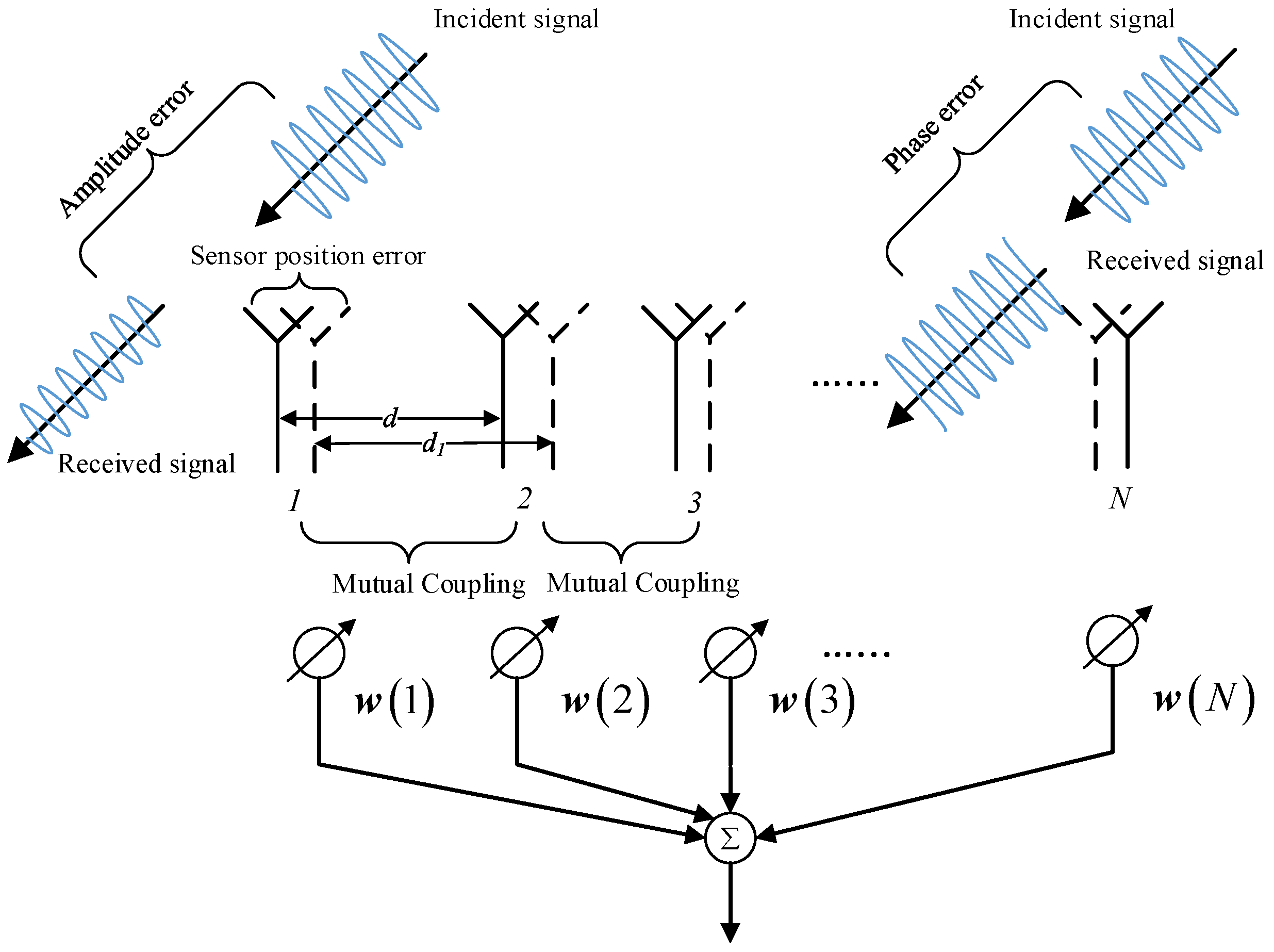
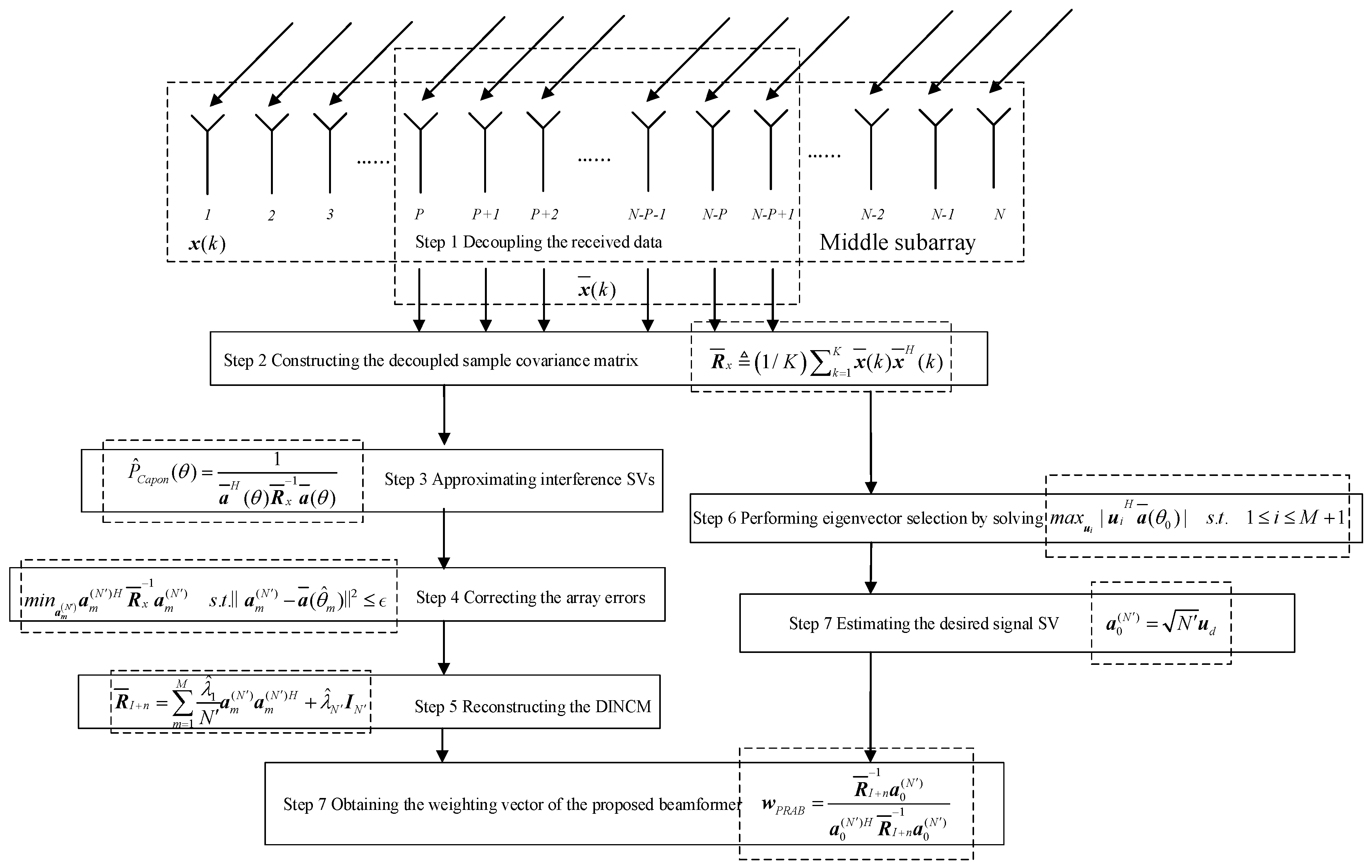
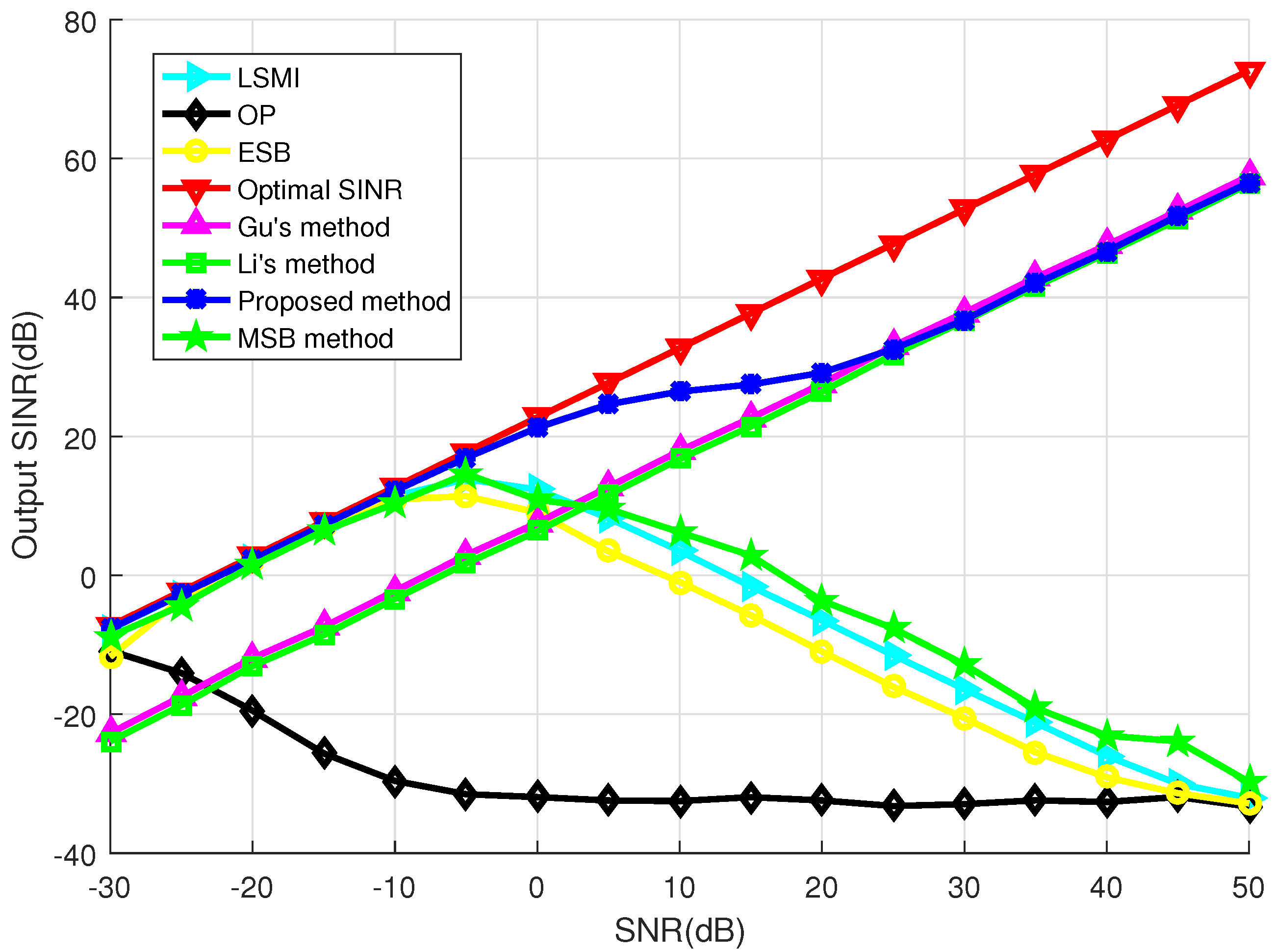
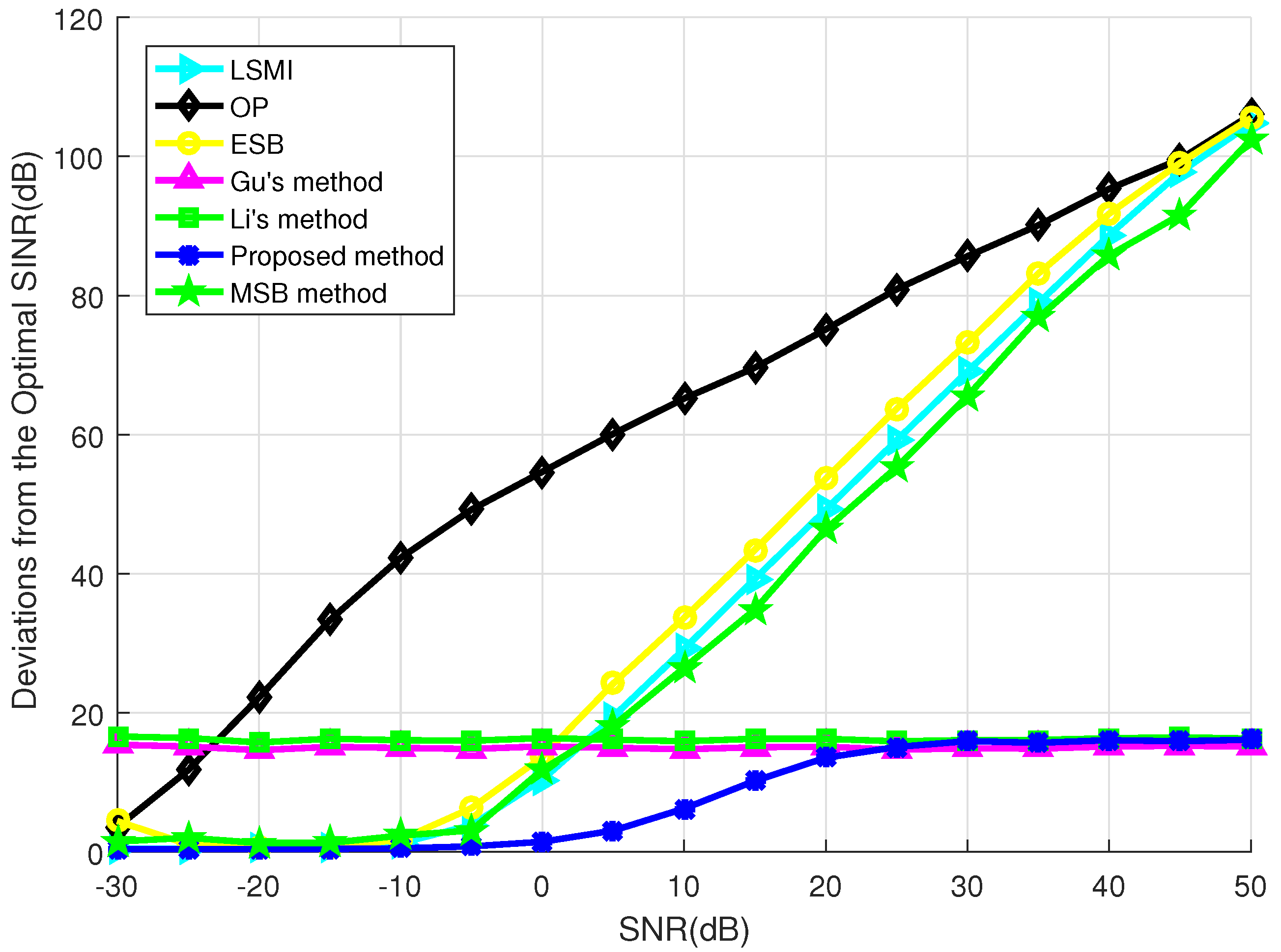

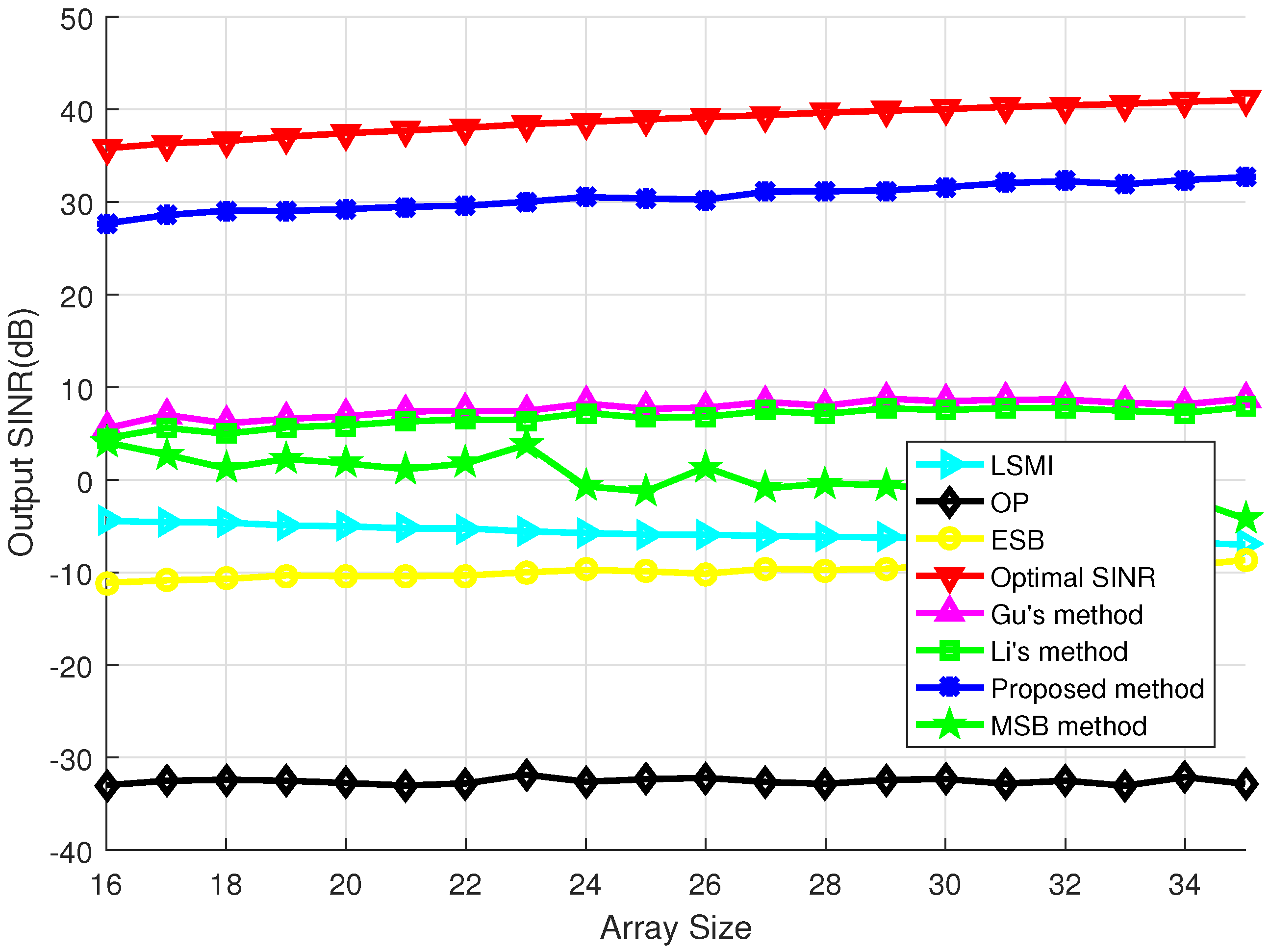
© 2020 by the authors. Licensee MDPI, Basel, Switzerland. This article is an open access article distributed under the terms and conditions of the Creative Commons Attribution (CC BY) license (http://creativecommons.org/licenses/by/4.0/).
Share and Cite
Xie, Z.; Zhu, J.; Fan, C.; Huang, X. An Improved Sub-Array Adaptive Beamforming Technique Based on Multiple Sources of Errors. J. Mar. Sci. Eng. 2020, 8, 757. https://doi.org/10.3390/jmse8100757
Xie Z, Zhu J, Fan C, Huang X. An Improved Sub-Array Adaptive Beamforming Technique Based on Multiple Sources of Errors. Journal of Marine Science and Engineering. 2020; 8(10):757. https://doi.org/10.3390/jmse8100757
Chicago/Turabian StyleXie, Zhuang, Jiahua Zhu, Chongyi Fan, and Xiaotao Huang. 2020. "An Improved Sub-Array Adaptive Beamforming Technique Based on Multiple Sources of Errors" Journal of Marine Science and Engineering 8, no. 10: 757. https://doi.org/10.3390/jmse8100757
APA StyleXie, Z., Zhu, J., Fan, C., & Huang, X. (2020). An Improved Sub-Array Adaptive Beamforming Technique Based on Multiple Sources of Errors. Journal of Marine Science and Engineering, 8(10), 757. https://doi.org/10.3390/jmse8100757





